
Journal of Inorganic Materials ›› 2025, Vol. 40 ›› Issue (2): 128-144.DOI: 10.15541/jim20240355
Special Issue: 【信息功能】介电、铁电、压电材料(202506)
• REVIEW • Previous Articles Next Articles
TAO Guilong1,2( ), ZHI Guowei2, LUO Tianyou2, OUYANG Peidong2, YI Xinyan3, LI Guoqiang1,2,3(
), ZHI Guowei2, LUO Tianyou2, OUYANG Peidong2, YI Xinyan3, LI Guoqiang1,2,3( )
)
Received:2024-07-27
Revised:2024-09-12
Published:2025-02-20
Online:2024-11-25
Contact:
LI Guoqiang, professor. E-mail: msgli@scut.edu.cnAbout author:TAO Guilong (1988-), male, PhD candidate. E-mail: ictgl@mail.scut.edu.cn
Supported by:CLC Number:
TAO Guilong, ZHI Guowei, LUO Tianyou, OUYANG Peidong, YI Xinyan, LI Guoqiang. Progress on Key Technologies of Cavity-structured Thin Film Bulk Acoustic Wave Filter[J]. Journal of Inorganic Materials, 2025, 40(2): 128-144.
| Filter type | SAW filter | BAW filter |
|---|---|---|
| Characteristic | High stability, low insertion loss (2-4 dB) | High stability, low insertion loss (0.8-1.5 dB), high power tolerance |
| Applicable frequency range | 10 MHz-3 GHz | 1.5-6 GHz, the maximum up to over 10 GHz |
| Advantage | Smaller than the traditional ceramic filter, flexible, mature technology, high reliability | Suitable for high frequency, insensitive to temperature changes, miniaturized vertical propagation in acoustic wave, decreased size according to frequency increase |
| Limitation | Poor thermal stability, decreased Q-value when operating frequency exceeds 1.5 GHz | High manufacturing cost, complex manufacturing process |
Table 1 Technical characteristics of SAW filter and BAW filter
| Filter type | SAW filter | BAW filter |
|---|---|---|
| Characteristic | High stability, low insertion loss (2-4 dB) | High stability, low insertion loss (0.8-1.5 dB), high power tolerance |
| Applicable frequency range | 10 MHz-3 GHz | 1.5-6 GHz, the maximum up to over 10 GHz |
| Advantage | Smaller than the traditional ceramic filter, flexible, mature technology, high reliability | Suitable for high frequency, insensitive to temperature changes, miniaturized vertical propagation in acoustic wave, decreased size according to frequency increase |
| Limitation | Poor thermal stability, decreased Q-value when operating frequency exceeds 1.5 GHz | High manufacturing cost, complex manufacturing process |

Fig. 1 Operating principle of the L-type FBAR filter (a) Electrical characteristics of the idealized FBAR; (b) Fundamental unit of the L-type structure; (c) Transmission response
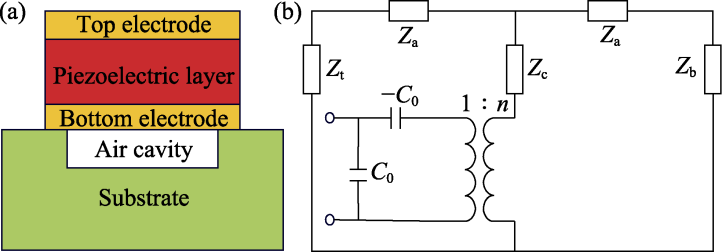
Fig. 2 FBAR and the equivalent circuit model of piezoelectric thin film (a) Schematic structure of FBAR; (b) Mason equivalent circuit model of the piezoelectric thin film
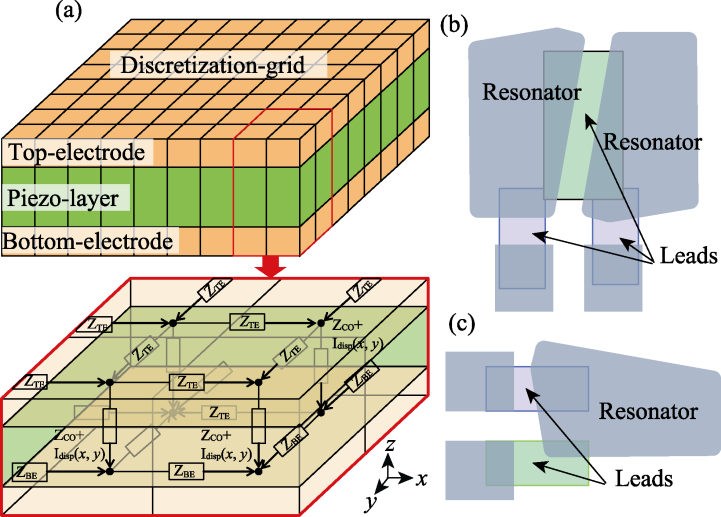
Fig. 7 Discretized model and electrode feed lines of BAW resonator[36] (a) Schematic representation of discretized resonator model; (b) Two resonators in series and connected by broad lead; (c) Single resonator connected by narrow lead
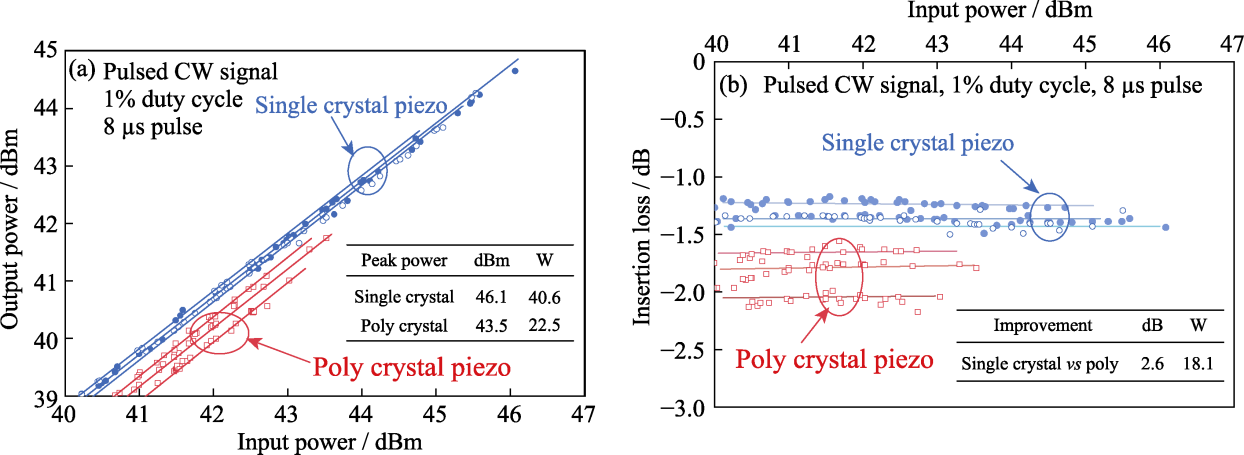
Fig. 8 3.55 GHz FBAR filter based on single-crystal and polycrystalline AlN[54] (a) Measured power sweep at right band edge of the filters; (b) Measured insertion loss of the filters versus input power

Fig. 11 Experimental results of FBAR filter fabricated with Al0.8Sc0.2N film[65] (a) Transmission response of FBAR filter; (b) Return loss of the FBAR filter
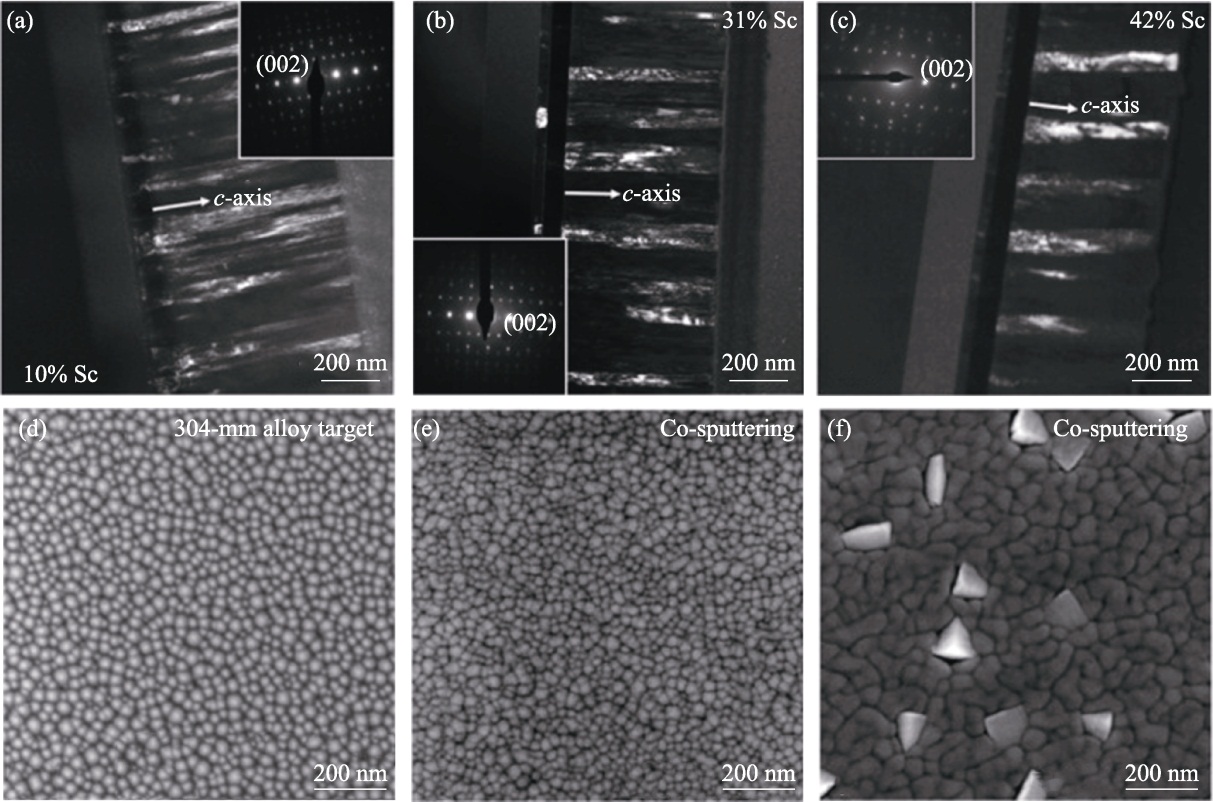
Fig. 12 Effect of Sc-dopant concentration on crystal quality and surface morphology of Al1−xScxN thin films[69] (a-c) TEM dark-field images and electron diffraction patterns for 10%, 31%, and 42% Sc content; (d-f) Corresponding SEM plane views
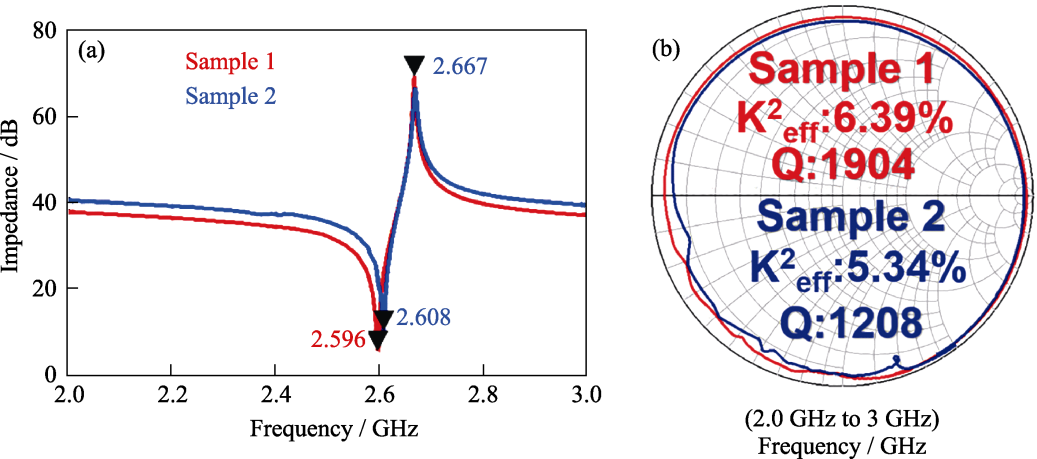
Fig. 13 Performance comparison of FBAR obtained by two-step (Sample 1) and single PVD (Sample 2) processes[86] (a) Frequency impedance characteristic curves; (b) Smith chart

Fig. 14 Schematic diagram for SABAR process[87] (a) Combination of PLD and MOCVD AlN film; (b) Bottom electrode and bonding layer sputtered on top of AlN layer; (c) Resonator structure
| [14] | FELD D A, PARKER R, RUBY R, et al. After 60 years: a new formula for computing quality factor is warranted. 2008 IEEE Ultrasonics Symposium, Beijing, 2008: 431. |
| [15] | UEDA M, NISHIHARA T, TANIGUCHI S, et al. Film bulk acoustic resonator using high-acoustic-impedance electrodes. Japanese Journal of Applied Physics, 2007, 46(7S): 4642. |
| [16] | KAITILA J. 3C-1 review of wave propagation in BAW thin film devices-progress and prospects. 2007 IEEE Ultrasonics Symposium Proceedings, New York, 2007: 120. |
| [17] | LIN Y C, HONG C R, CHUANG H A. Fabrication and analysis of ZnO thin film bulk acoustic resonators. Applied Surface Science, 2008, 254(13): 3780. |
| [18] | KAMOHARA T, AKIYAMA M, KUWANO N. Influence of molybdenum bottom electrodes on crystal growth of aluminum nitride thin films. Journal of Crystal Growth, 2008, 310(2): 345. |
| [19] | NOR N I M, SHAH K, SINGH J J, et al. Film bulk acoustic wave resonator (FBAR) filter for Ku-band transceiver. Nanotechnology Conference and Expo (NSTI-Nanotech 2013), Washington, 2013: 169. |
| [20] | CLEMENT M, IBORRA E, OLIVARES J, et al. DCS Tx filters using AlN resonators with iridium electrodes. IEEE Transactions on Ultrasonics Ferroelectrics and Frequency Control, 2010, 57(3): 518. |
| [21] | AIGNER R. MEMS in RF-filter applications: thin film bulk- acoustic-wave technology. 13th International Conference on Solid- State Sensors, Actuators and Microsystems, Seoul, 2005: 5. |
| [22] | LI Y, GONG K, WONG Y P, et al. Comparative study of piston mode designs for temperature-compensated surface acoustic wave resonators using SiO2/LiNbO3 structure. Japanese Journal of Applied Physics, 2022, 61(SG): SG1020. |
| [23] | NAKAGAWA R, SUZUKI T, SHIMIZU H, et al. Discussion about generation mechanisms of third-order nonlinear signals in surface acoustic wave resonators based on simulation. Japanese Journal of Applied Physics, 2016, 55(7S1): 07KD02. |
| [24] | UEDA M, IWAKI R, NISHIHARA R, et al. Nonlinear distortion of acoustic devices for radio-frequency front-end circuit and its suppression. Japanese Journal of Applied Physics, 2010, 49(7S): 07HD12. |
| [25] | HASHIMOTO K Y, LI X, BAO J, et al. Perturbation analysis of nonlinearity in radio frequency bulk acoustic wave resonators using mass-spring model. IEEE Transactions on Ultrasonics Ferroelectrics and Frequency Control, 2020, 67(7): 1479. |
| [26] | PANG X N, YONG Y K. Simulation of nonlinear resonance, amplitude-frequency, and harmonic generation effects in SAW and BAW devices. IEEE Transactions on Ultrasonics Ferroelectrics and Frequency Control, 2019, 67(2): 422. |
| [27] | SCHNEIDER J D, LU T, TIWARI S, et al. Frequency conversion through nonlinear mixing in acoustic waves. Journal of Applied Physics, 2020, 128(6): 064105. |
| [28] | ASSILA N, KADOTA M, OHASHI Y, et al. High velocity lamb waves in LiTaO3 thin plate for high frequency filters. 2016 IEEE International Frequency Control Symposium (IFCS), New Orleans, 2016: 333. |
| [29] | HE Y, WONG Y P, WU T, et al. Full 3D FEM simulation of thickness shear bulk acoustic resonators on LN assisted by hierarchical cascading technique. 2021 IEEE International Ultrasonics Symposium (IUS), Xi'an, 2021: 1. |
| [30] | QIU L, LI X Y, MATSUOKA N, et al. Emphasis mechanism of nonlinear responses caused by transverse modes in RF BAW devices. Japanese Journal of Applied Physics, 2020, 59(SK): SKKC02. |
| [31] | NGUYEN N T B, JOHANNESSEN A, HANKE U. Design of high-Q thin film bulk acoustic resonator using dual-mode reflection. 2014 IEEE International Ultrasonics Symposium, Chicago, 2014: 487. |
| [32] | LI X, BAO J, HUANG Y, et al. Use of double-raised-border structure for quality factor enhancement of type II piston mode FBAR. Microsystem Technologies, 2018, 24(7): 2991. |
| [33] | NGUYEN N, JOHANNESSEN A, ROOTH S, et al. A design approach for high-Q FBARs with a dual-step frame. IEEE Transactions on Ultrasonics Ferroelectrics and Frequency Control, 2018, 65(9): 1717. |
| [34] | REN J, CHU H, BAI Y, et al. Research and design of high sensitivity FBAR micro-mass sensors. 2020 Asia Conference on Geological Research and Environmental Technology, Kamakura, 2021: 042014. |
| [35] | SETOODEH S, KEMIKTARAK U, BAYATPUR F, et al. A high power circuit model of an FBAR resonator for use in filter design. 2019 IEEE International Ultrasonics Symposium (IUS), Glasgow, 2019: 2169. |
| [36] | FATTINGER M, KREUZER S. BAW filters for 5G: lead geometry impact on current distribution in resonators. 2020 IEEE MTT-S International Conference on Microwaves for Intelligent Mobility (ICMIM), Linz, 2020: 1. |
| [37] | LIU Y, SUN K, MA J, et al. Design and fabrication of temperature-compensated film bulk acoustic resonator filter based on the stress compensation effect. Coatings, 2022, 12(8): 1126. |
| [38] | WU X, XU L, SHI G, et al. Design and modeling of film bulk acoustic resonator considering temperature compensation for 5G communication. Analog Integrated Circuits and Signal Processing, 2024, 118(2): 219. |
| [39] | HAOPENG W, CAI X, WU Y, et al. An investigation on extraction of material parameters in longitudinal mode of FBAR. IEEE Transactions on Circuits and Systems II: Express Briefs, 2020, 67(6): 1024. |
| [40] | NOR N I M, HASNI A H M, KHALID N, et al. Carbon nanotube as electrode in film bulk acoustic wave resonator for improved performance. International Conference on Applied Photonics and Electronics 2019 (InCAPE 2019), Putrajaya, 2020: 020021. |
| [41] | LU R, YANG Y, LINK S, et al. A 1 resonators in 128° Y-cut lithium niobate with electromechanical coupling of 46.4%. Journal of Microelectromechanical Systems, 2020, 29(3): 313. |
| [42] | SATOH Y, NISHIHARA T, YOKOYAMA T, et al. Development of piezoelectric thin film resonator and its impact on future wireless communication systems. Japanese Journal of Applied Physics, 2005, 44(5A): 2883. |
| [43] | WANG L P, GINSBURG E, GERFERS F, et al. Sputtered AlN thin films for piezoelectric MEMS devices. SENSORS, 2006 IEEE, Daegu, 2006: 10. |
| [44] | MAHON S. The 5G effect on RF filter technologies. IEEE Transactions on Semiconductor Manufacturing, 2017, 30(4): 494. |
| [45] | AIGNER R, FATTINGER G, SCHAEFER M, et al. BAW filters for 5G bands. 2018 IEEE International Electron Devices Meeting (IEDM), San Francisco, 2018: 1451. |
| [46] | LI G, KIM T W, INOUE S, et al. Epitaxial growth of single- crystalline AlN films on tungsten substrates. Applied Physics Letters, 2006, 89(24): 241905. |
| [47] | YANG H, WANG W, LIU Z, et al. Epitaxial growth of 2 inch diameter homogeneous AlN single-crystalline films by pulsed laser deposition. Journal of Physics D-Applied Physics, 2013, 46(10): 105101. |
| [48] | LIN Y, YANG M, WANG W, et al. High-quality crack-free GaN epitaxial films grown on Si substrates by a two-step growth of AlN buffer layer. CrystEngComm, 2016, 18(14): 2446. |
| [49] | JIANGHUA L, WENLIANG W, YULIN Z, et al. AlN/nitrided sapphire and AlN/non-nitrided sapphire hetero-structures epitaxially grown by pulsed laser deposition: a comparative study. Vacuum, 2017, 143: 241. |
| [50] | WANG H, LI Z, WANG W, et al. Growth mechanisms of GaN epitaxial films grown on ex situ low-temperature AlN templates on Si substrates by the combination methods of PLD and MOCVD. Journal of Alloys and Compounds, 2017, 718: 28. |
| [51] | SHEALY J B, SHEALY J B, PATEL P, et al. Single crystal aluminum nitride film bulk acoustic resonators. 2016 IEEE Radio and Wireless Symposium (RWS), Austin, 2016: 16. |
| [52] | SHEALY J B, VETURY R, GIBB S R, et al. Low loss, 3.7 GHz wideband BAW filters, using high power single crystal AlN-on-SiC resonators. 2017 IEEE MTT-S International Microwave Symposium (IMS), Honololu, 2017: 1476. |
| [53] | VETURY R, HODGE M D, SHEALY J B. High power, wideband single crystal XBAW technology for sub-6 GHz micro RF filter applications. 2018 IEEE International Ultrasonics Symposium (IUS), Kobe, 2018: 206. |
| [54] | SHEN Y, ZHANG R, VETURY R, et al. 40.6 watt, high power 3.55 GHz single crystal XBAW RF filters for 5G infrastructure applications. 2020 IEEE International Ultrasonics Symposium (IUS), Las Vegas, 2020: 1. |
| [55] | DING R, XUAN W, DONG S, et al. The 3.4 GHz BAW RF filter based on single crystal AlN resonator for 5G application. Nanomaterials, 2022, 12(17): 3082. |
| [56] | QIN R, ZHOU C, DOU W, et al. 3.3 GHz BAW resonators fabricated on single crystal AlN templates. 2023 IEEE International Ultrasonics Symposium (IUS), Montreal, 2023: 1. |
| [57] | AKIYAMA M, KAMOHARA T, KANO K, et al. Enhancement of piezoelectric response in scandium aluminum nitride alloy thin films prepared by dual reactive cosputtering. Advanced Materials, 2009, 21(5): 593. |
| [58] | MOREIRA M, BJURSTRÖM J, KATARDJEV I, et al. Aluminum scandium nitride thin-film bulk acoustic resonators for wide band applications. Vacuum, 2011, 86(1): 23. |
| [59] | UMEDA K, KAWAI H, HONDA A, et al. Piezoelectric properties of ScAlN thin films for piezo-MEMS devices. 2013 IEEE 26th International Conference on Micro Electro Mechanical Systems (MEMS), Taipei, 2013: 733. |
| [60] | SANO K H, KARASAWA R, YANAGITANI T. High electromechanical coefficient kt2=19% thick ScAlN piezoelectric films for ultrasonic transducer in low frequency of 80 MHz. 2017 IEEE International Ultrasonics Symposium (IUS), Washington, 2017: 1. |
| [61] | PARK M, WANG J, DARGIS R, et al. Super high-frequency scandium aluminum nitride crystalline film bulk acoustic resonators. 2019 IEEE International Ultrasonics Symposium (IUS), Glasgow, 2019: 1689. |
| [62] | MOE C, OLSSON R H, PATEL P, et al. Highly doped AlScN 3.5 GHz XBAW resonators with 16% keff2 for 5G RF filter applications. 2020 IEEE International Ultrasonics Symposium (IUS), Las Vegas, 2020: 1. |
| [63] | WANG J, PARK M, MERTIN S, et al. A film bulk acoustic resonator based on ferroelectric aluminum scandium nitride films. Journal of Microelectromechanical Systems, 2020, 29(5): 741. |
| [64] | KIM D, MORENO G, BI F, et al. Wideband 6 GHz RF filters for Wi-Fi 6E using a unique BAW process and highly Sc-doped AlN thin film. 2021 IEEE MTT-S International Microwave Symposium (IMS), Atlanta, 2021: 207. |
| [65] | ZOU Y, GAO C, ZHOU J, et al. Aluminum scandium nitride thin-film bulk acoustic resonators for 5G wideband applications. Microsystems & Nanoengineering, 2022, 8(1): 124. |
| [66] | DOU W, ZHOU C, QIN R, et al. Super-high-frequency bulk acoustic resonators based on aluminum scandium nitride for wideband applications. Nanomaterials, 2023, 13(20): 2737. |
| [67] | MOMIDA H, TESHIGAHARA A, OGUCHI T. Strong enhancement of piezoelectric constants in ScxAl1-xN: first-principles calculations. AIP Advances, 2016, 6(6): 065006. |
| [68] | BOGNER A, TIMME H J, BAUDER R, et al. Impact of high Sc content on crystal morphology and RF performance of sputtered Al1-xScxN SMR BAW. 2019 IEEE International Ultrasonics Symposium (IUS), Glasgow, 2019: 706. |
| [69] | MERTIN S, HEINZ B, RATTUNDE O, et al. Piezoelectric and structural properties of c-axis textured aluminium scandium nitride thin films up to high scandium content. Surface & Coatings Technology, 2018, 343: 2. |
| [70] | GREEN M L, CHOI C L, HATTRICK-SIMPERS J R, et al. Fulfilling the promise of the materials genome initiative with high-throughput experimental methodologies. Applied Physics Reviews, 2017, 4(1): 011105. |
| [71] | LIU Y H, HU Z H, SUO Z G, et al. High-throughput experiments facilitate materials innovation: a review. Science China (Technological Sciences), 2019, 62(4): 521. |
| [72] | DE PABLO J J, JACKSON N E, WEBB M A, et al. New frontiers for the materials genome initiative. npj Computational Materials, 2019, 5(1): 41. |
| [73] | WANG R, XU C, DONG R, et al. A secured big-data sharing platform for materials genome engineering: state-of-the-art, challenges and architecture. Future Generation Computer Systems-The International Journal of eScience, 2023, 142: 59. |
| [74] | HIMANEN L, GEURTS A, FOSTER A S, et al. Data-driven materials science: status, challenges, and perspectives. Advanced Science, 2019, 6(21): 1900808. |
| [75] | TAN C, WU H, YANG L, et al. Cutting edge high-throughput synthesis and characterization techniques in combinatorial materials science. Advanced Materials Technologies, 2024, 9(10): 2302038. |
| [76] | HATTRICK-SIMPERS J R, GREGOIRE J M, KUSNE A G. Perspective: composition-structure-property mapping in high-throughput experiments: turning data into knowledge. APL Materials, 2016, 4(5): 2832. |
| [77] | CASUKHELA R, VIJAYAN S, JINSCHEK J R, et al. A framework for the optimal selection of high-throughput data collection workflows by autonomous experimentation systems. Integrating Materials and Manufacturing Innovation, 2022, 11(4): 557. |
| [78] | LUDWIG A. Discovery of new materials using combinatorial synthesis and high-throughput characterization of thin-film materials libraries combined with computational methods. npj Computational Materials, 2019, 5(1): 70. |
| [79] | MANNA S, BRENNECKA G L, STEVANOVIC V, et al. Tuning the piezoelectric and mechanical properties of the AlN system via alloying with YN and BN. Journal of Applied Physics, 2017, 122(10): 105101. |
| [1] |
CHAUHAN V, HUCK C, FRANK A, et al. Enhancing RF bulk acoustic wave devices: multiphysical modeling and performance. IEEE Microwave Magazine, 2019, 20(10): 56.
DOI |
| [2] | WU Z, SHI B, LI Y, et al. Use of heavy dielectric materials in solidly mounted A 1 mode resonators based on lithium niobate. Japanese Journal of Applied Physics, 2022, 61(SG): SG1001. |
| [3] | LI M, EL-HAKIKI M, KALIM D, et al. A fully matched LTE-A carrier aggregation quadplexer based on BAW and SAW technologies. 2014 IEEE International Ultrasonics Symposium, Chicago, 2014: 77. |
| [4] | CHEN J C, YANG H Y, WU J W, et al. Widening the data pipeline: a carrier aggregation BAW quadplexer module. IEEE Microwave Magazine, 2018, 19(2): 62. |
| [5] | LIU Y, CAI Y, ZHANG Y, et al. Materials, design, and characteristics of bulk acoustic wave resonator: a review. Micromachines, 2020, 11(7): 630. |
| [6] | AIGNER R, FATTINGER G. 3G-4G-5G:how BAW filter technology enables a connected world. 2019 20th International Conference on Solid-State Sensors, Actuators and Microsystems & Eurosensors XXXIII (TRANSDUCERS & EUROSENSORS XXXIII), Berlin, 2019: 523. |
| [7] | LAKIN K M, KLINE G R, MCCARRON K T. High-Q microwave acoustic resonators and filters. IEEE Transactions on Microwave Theory and Techniques, 1993, 41(12): 2139. |
| [8] | FATTINGER G G. BAW resonator design considerations-an overview. 2008 IEEE International Frequency Control Symposium, Honolulu, 2008: 762. |
| [9] | HEEREN W, FATTINGER M, FATTINGER G, et al. Impact of thermo-mechanical stress on the TCF of WLP BAW filters. 2016 IEEE International Ultrasonics Symposium (IUS), Tours, 2016: 1. |
| [10] | BI F Z, BARBER B P. Bulk acoustic wave RF technology. IEEE Microwave Magazine, 2008, 9(5): 65. |
| [11] | RUBY R. The ‘how & why’ a deceptively simple acoustic resonator became the basis of a multi-billion dollar industry. 2017 IEEE 30th International Conference on Micro Electro Mechanical Systems (MEMS), Las Vegas, 2017: 308. |
| [12] | LAKIN K, BELSICK J, MCDONALD J, et al. Improved bulk wave resonator coupling coefficient for wide bandwidth filters. 2001 IEEE Ultrasonics Symposium. Proceedings. An International Symposium (Cat. No. 01CH37263), Atlanta, 2001: 827. |
| [13] | RUBY R. Review and comparison of bulk acoustic wave FBAR, SMR technology. 2007 IEEE Ultrasonics Symposium, New York, 2007: 1029. |
| [80] |
HIRATA K, YAMADA H, UEHARA M, et al. First-principles study of piezoelectric properties and bonding analysis in (Mg, X, Al)N solid solutions (X = Nb, Ti, Zr, Hf). ACS Omega, 2019, 4(12): 15081.
DOI PMID |
| [81] | HIRATA K, MORI Y, YAMADA H, et al. Significant enhancement of piezoelectric response in AlN by Yb addition. Materials, 2021, 14(2): 309. |
| [82] | YU X, ZHU L, LI X, et al. Doping engineering for optimizing piezoelectric and elastic performance of AlN. Materials, 2023, 16(5): 1778. |
| [83] | BOUSQUET M, PERREAU P, JOULIE A, et al. 4.2 GHz LiNbO3 film bulk acoustic resonator. 2021 IEEE International Ultrasonics Symposium (IUS), Xi'an, 2021: 1. |
| [84] | REINHARDT A, BOUSQUET M, JOULIE A, et al. Lithium niobate film bulk longitudinal wave resonator. 2021 Joint Conference of the European Frequency and Time Forum and IEEE International Frequency Control Symposium (EFTF/IFCS), Gainesville, 2021: 1. |
| [85] | BOUSQUET M, BOREL E, JOULIE A, et al. LiNbO3 film bulk acoustic resonator for n79 band. 2022 IEEE International Ultrasonics Symposium (IUS), Venice, 2022: 1. |
| [86] | YI X, ZHAO L, OUYANG P, et al. High-quality film bulk acoustic resonators fabricated on AlN films grown by a new two-step method. IEEE Electron Device Letters, 2022, 43(6): 942. |
| [87] | OUYANG P, YI X, LI G. Single-crystalline bulk acoustic wave resonators fabricated with AlN film grown by a combination of PLD and MOCVD methods. IEEE Electron Device Letters, 2024, 45(4): 538. |
| [88] | ZUO C, HE C, CHENG W, et al. Hybrid filter design for 5G using IPD and acoustic technologies. 2019 IEEE International Ultrasonics Symposium (IUS), Glasgow, 2019: 269. |
| [89] | CHEN L, LING F. Addressing 5G NR filter challenges with hybrid technologies. 2022 IEEE 72nd Electronic Components and Technology Conference (ECTC), San Diego, 2022: 1914. |
| [90] | DING R, XUAN W, GAO F, et al. Compact and high steep skirts hybrid heterogeneous integrated N77 full band BAW filter based on band-stop theory. IEEE Electron Device Letters, 2024, 45(5): 793. |
| [91] | BOGNER A, BAUDER R, TIMME H J, et al. All-pass based filter design using BAW resonators. 2019 IEEE International Ultrasonics Symposium (IUS), Glasgow, 2019: 1685. |
| [92] | WU H P, WU Y L, LAI Z G, et al. A hybrid film-bulk- acoustic-resonator/coupled-line/transmission-line high selectivity wideband bandpass FBAR filter. IEEE Transactions on Microwave Theory and Techniques, 2020, 68(8): 3389. |
| [93] | WU H P, WU Y L, LAI Z G, et al. A hybrid filter with extremely wide bandwidth and high selectivity using FBAR network. IEEE Transactions on Circuits and Systems II-Express Briefs, 2022, 69(7): 3164. |
| [94] | SUN J I, SUN S, YU X, et al. A deep neural network based tuning technique of lossy microwave coupled resonator filters. Microwave and Optical Technology Letters, 2019, 61(9): 2169. |
| [95] | SALLAM T, ATTIYA A M. Convolutional neural network for coupling matrix extraction of microwave filters. Applied Computational Electromagnetics Society Journal, 2022, 37(7): 805. |
| [96] | REN Y, DENG X, YOU Z, et al. 1-D multi-channel CNN with transfer functions for inverse electromagnetic behaviors modeling and design optimization of high-dimensional filters. Applied Intelligence, 2023, 54(1): 503. |
| [97] | FU J, JIN J, YANG J, et al. Feature-assisted neural network surrogate-based multiphysics optimization for microwave filters. IEEE Microwave and Wireless Technology Letters, 2024, 34(5): 474. |
| [98] | BALTEANU F, DROGI S, CHOI Y, et al. Multiple transmitter coexistence for 5G RF front end modules. 2021 51st European Microwave Conference (EuMC), London, 2022: 180. |
| [99] | MOREIRA C P, SHIRAKAWA A A, KERHERVE E, et al. Design of a fully-integrated BiCMOS/FBAR reconfigurable RF receiver front-end. 18th annual symposium on Integrated circuits and system design, New York, 2005: 138. |
| [100] | PILLAI G, ZOPE A A, TSAI M L, et al. 3-GHz BAW composite resonators integrated with CMOS in a single-chip configuration. 2016 IEEE International Frequency Control Symposium (IFCS), New Orleans, 2016: 1. |
| [101] | GAO C, ZHANG M, JIANG Y, et al. A monolithic FBAR oscillator based on heterogeneous system-on-chip integration. 2019 IEEE 32nd International Conference on Micro Electro Mechanical Systems (MEMS), Seoul, 2019: 895. |
| [102] | CAMPANELLA H, QIAN Y, ROMERO C O, et al. Monolithic multiband MEMS RF front-end module for 5G mobile. Journal of Microelectromechanical Systems, 2020, 30(1): 72. |
| [103] | YU H, WANG X, PENG X, et al. Performance optimization of FBAR filters with wafer-level chip-scale package using embedded matching inductors on multilayer PCB. 2022 IEEE MTT-S International Microwave Workshop Series on Advanced Materials and Processes for RF and THz Applications (IMWS-AMP), Guangzhou, 2022: 1. |
| [1] | YU Shengyang, SU Haijun, JIANG Hao, YU Minghui, YAO Jiatong, YANG Peixin. A Review of Pore Defects in Ultra-high Temperature Oxide Ceramics by Laser Additive Manufacturing: Formation and Suppression [J]. Journal of Inorganic Materials, 2025, 40(9): 944-956. |
| [2] | LIU Jiangping, GUAN Xin, TANG Zhenjie, ZHU Wenjie, LUO Yongming. Research Progress on Catalytic Oxidation of Nitrogen-containing Volatile Organic Compounds [J]. Journal of Inorganic Materials, 2025, 40(9): 933-943. |
| [3] | XIAO Xiaolin, WANG Yuxiang, GU Peiyang, ZHU Zhenrong, SUN Yong. Advances in Regulation of Damaged Skin Regeneration by Two-dimensional Inorganic Materials [J]. Journal of Inorganic Materials, 2025, 40(8): 860-870. |
| [4] | MA Jingge, WU Chengtie. Application of Inorganic Bioceramics in Promoting Hair Follicle Regeneration and Hair Growth [J]. Journal of Inorganic Materials, 2025, 40(8): 901-910. |
| [5] | ZHANG Hongjian, ZHAO Ziyi, WU Chengtie. Inorganic Biomaterials on Regulating Neural Cell Function and Innervated Tissue Regeneration: A Review [J]. Journal of Inorganic Materials, 2025, 40(8): 849-859. |
| [6] | AI Minhui, LEI Bo. Micro-nanoscale Bioactive Glass: Functionalized Design and Angiogenic Skin Regeneration [J]. Journal of Inorganic Materials, 2025, 40(8): 921-932. |
| [7] | WANG Yutong, CHANG Jiang, XU He, WU Chengtie. Advances in Silicate Bioceramic/Bioglass for Wound Healing: Effects, Mechanisms and Application Ways [J]. Journal of Inorganic Materials, 2025, 40(8): 911-920. |
| [8] | MA Wenping, HAN Yahui, WU Chengtie, LÜ Hongxu. Application of Inorganic Bioactive Materials in Organoid Research [J]. Journal of Inorganic Materials, 2025, 40(8): 888-900. |
| [9] | LUO Xiaomin, QIAO Zhilong, LIU Ying, YANG Chen, CHANG Jiang. Inorganic Bioactive Materials Regulating Myocardial Regeneration [J]. Journal of Inorganic Materials, 2025, 40(8): 871-887. |
| [10] | ZHU Wenjie, TANG Lu, LU Jichang, LIU Jiangping, LUO Yongming. Research Progress on Catalytic Oxidation of Volatile Organic Compounds by Perovskite Oxides [J]. Journal of Inorganic Materials, 2025, 40(7): 735-746. |
| [11] | HU Zhichao, YANG Hongyu, YANG Hongcheng, SUN Chengli, YANG Jun, LI Enzhu. Usage of the P-V-L Bond Theory in Regulating Properties of Microwave Dielectric Ceramics [J]. Journal of Inorganic Materials, 2025, 40(6): 609-626. |
| [12] | WU Qiong, SHEN Binglin, ZHANG Maohua, YAO Fangzhou, XING Zhipeng, WANG Ke. Research Progress on Lead-based Textured Piezoelectric Ceramics [J]. Journal of Inorganic Materials, 2025, 40(6): 563-574. |
| [13] | ZHANG Bihui, LIU Xiaoqiang, CHEN Xiangming. Recent Progress of Hybrid Improper Ferroelectrics with Ruddlesden-Popper Structure [J]. Journal of Inorganic Materials, 2025, 40(6): 587-608. |
| [14] | WU Jie, YANG Shuai, WANG Mingwen, LI Jinglei, LI Chunchun, LI Fei. Textured PT-based Piezoelectric Ceramics: Development, Status and Challenge [J]. Journal of Inorganic Materials, 2025, 40(6): 575-586. |
| [15] | JIANG Kun, LI Letian, ZHENG Mupeng, HU Yongming, PAN Qinxue, WU Chaofeng, WANG Ke. Research Progress on Low-temperature Sintering of PZT Ceramics [J]. Journal of Inorganic Materials, 2025, 40(6): 627-638. |
| Viewed | ||||||
|
Full text |
|
|||||
|
Abstract |
|
|||||